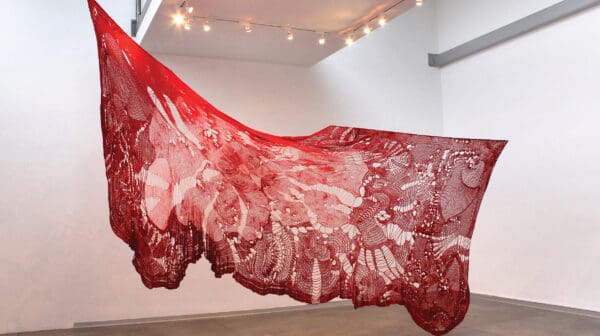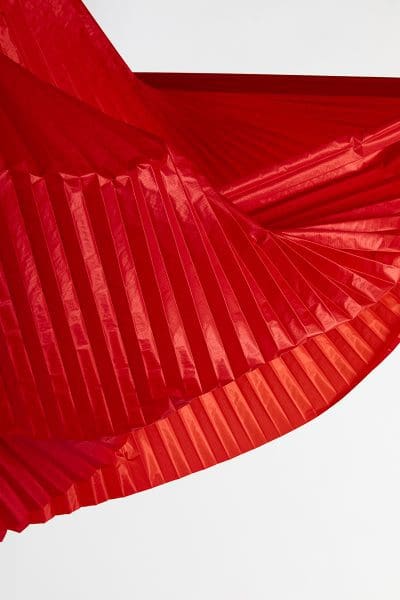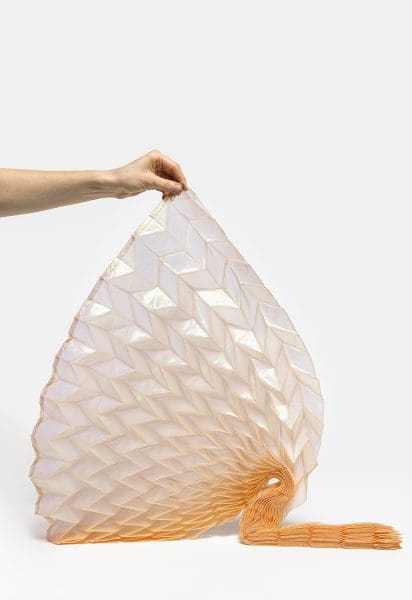
First Nations artists share their sun stories
For the 24th Biennale of Sydney, Paris-based Fondation Cartier has commissioned 14 new works by Indigenous artists across the globe, curated by renowned Kuku Yalanji artist, Tony Albert.





As the 2017 Research Fellow at MAAS (the Museum of Applied Arts and Sciences), Sydney-based artist Kate Scardifield had access to a treasure trove of antique scientific equipment, charts and archival material. Her investigation into 19th century astronomical devices in the collection added to her knowledge of maritime navigation processes. The artist’s solo exhibition, Soft Topologies, brings an artistic appreciation to the material forms and cultural role of scientific devices. Scardifield spoke with Sheridan Coleman while she was at UTS Gallery where she was developing her ‘adaptable textiles,’ which chart space and movement, ahead of the show.
Sheridan Coleman: What first attracted you to working with the MAAS collection?
Kate Scardifield: I began the fellowship wanting to access material related to a man called Thomas Brisbane who was the governor of NSW in the early 19th century. From what I understand, he didn’t do a huge amount of governing but he was a keen astronomer. The Powerhouse Museum and Sydney Observatory [which are both under the MAAS umbrella] actually have a number of Brisbane’s astronomical instruments that he brought to Australia from his observatory in Largs, Scotland. He furnished the first observatory, in Parramatta Park.
SC: How did you begin to explore the MAAS collection?
KS: MAAS has a collection of over 500,000 objects.
I’m a visual artist, not an astronomer, so I was really fortunate to approach these objects, and sketch and photograph them. Dr Andrew Jacob, the curator and astronomer at the observatory told me their stories. It became apparent how significant they were. They contributed to the process of standardising time, they were used in drawing up the title charts for Sydney waters. Thomas Brisbane was responsible for one of the first compendiums that mapped the stars in the southern hemisphere. That was a really special thing to uncover in the research process.
SC: These are all measuring instruments. How does measurement figure into your practice?
KS: My research into Thomas Brisbane and celestial navigation comes from a really personal place. I grew up sailing, and I come from a sailing family. I spent a lot of time on boats as a child, and with my parents. We would look at the stars, find constellations and talk about crossing bodies of water according to what we saw in the sky. Instruments are important to navigation and determining your position in landscape and in space.
SC: Where did the title Soft Topologies come from?
KS: I work with textiles a lot, creating adaptable forms from cloth and fabric. The idea of ‘soft topologies’ came from thinking about a material that had a looseness and a fluidity to it, that wasn’t fixed or static. That’s what I think about when I think about maps. We’re used to positioning maps as finite and authoritative, but depending on what data you use, what perspective you look from, maps can change drastically and quickly. The word ‘softness’ describes a continuing, undulating sense of movement.
SC: Technology and cartography change over time. You must have encountered some obsolescence in the collection?
KS: There was one particular piece I really gravitated towards called the Troughton Mural Circle. It’s a beautiful brass telescope component. It’s not usable now that it’s separated from the rest of the instrument. It’s beyond obsolescence in a way, just a fragment of another object.
SC: Walk me through your show Soft Topologies.
KS: This has been quite a unique show to develop. I’m in UTS gallery right now and it’s the first show of the year, so I will have had access for six weeks by the time the exhibition opens. A lot of the work has been made in the space, a bit like an informal residency. It’s nice to turn that part of the process outwards. I’ve been able to react to the architecture. The gallery has movable walls that you can reconfigure. I’ve kept an open central space and I’ve laid some of the walls on their sides, so they operate as a stage for the adaptable textiles to rest on. From the collection, I’ll showcase some parts of a telescope and some parts of a clock; although they’re not recognisable as those things, they are abstracted. This was intentional because the adaptable textiles are quite abstract as well.

SC: How will the adaptable textiles be arranged in the gallery?
KS: The textile forms are made from materials including sail cloths and spinnaker fabric: boating materials. They have a particular structure and texture. They’re folded and pleated and have these expandable and collapsible frameworks. I’ve been calling the textiles ‘propositional sculptures.’
To tease this out, I’m inviting participants from different fields and industries to come and have movement sessions with me during the exhibition. They will approach the textiles differently to how I would as a visual artist. There will be a choreographer, a sail maker, a percussionist and an engineer. We’re going to reshape these textile forms and have conversations through those materials. The gallery will be in a state of constant change.
SC: Was there a particular part of the collection that made you think differently about movement, space, time, or how we measure it?
KS: At the beginning, when I was still getting the lay of the land, Dr Andrew Jacobs walked me through the observatory, up to a big 19th century domed telescope. He put his hand on this huge sandstone pillar and told me it was part of the telescope. He said in order for a telescope of this magnitude to capture images of the distant universe, it needs to be as stable as possible. It’s rooted down into bedrock. That moment revealed for me this incredible push and pull: this structure is grounded in the earth but has the capacity to see hundreds of thousands of light-years away. It really spoke to me and I’ve held that above/below notion close all throughout developing this exhibition. It is something that will influence the trajectory of my work going forward.
Soft Topologies
Kate Scardifield
UTS Gallery
27 February – 20 April 2018